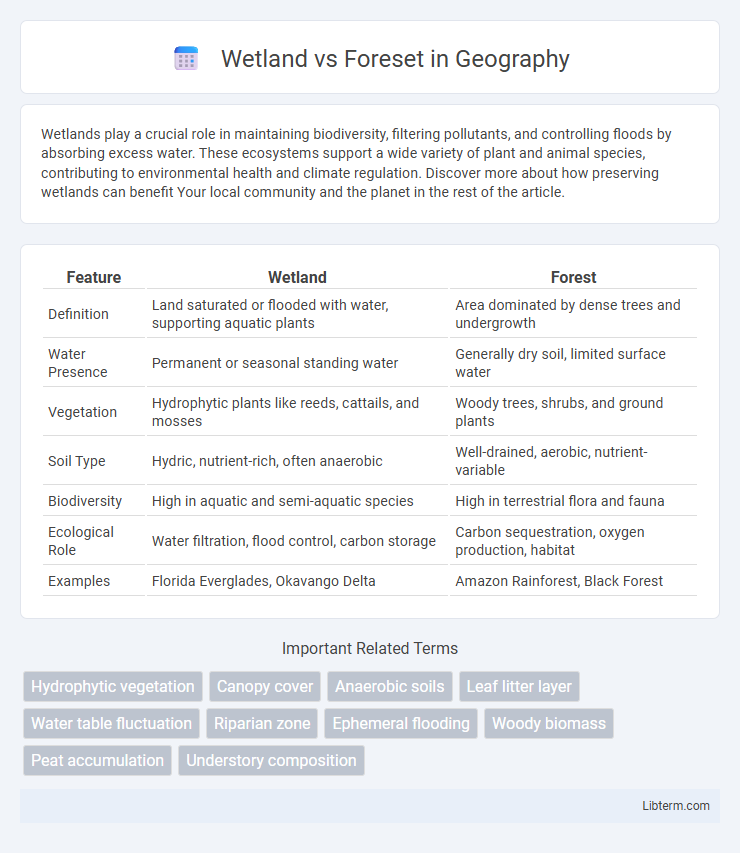Wetlands play a crucial role in maintaining biodiversity, filtering pollutants, and controlling floods by absorbing excess water. These ecosystems support a wide variety of plant and animal species, contributing to environmental health and climate regulation. Discover more about how preserving wetlands can benefit Your local community and the planet in the rest of the article.
Table of Comparison
| Feature | Wetland | Forest |
|---|---|---|
| Definition | Land saturated or flooded with water, supporting aquatic plants | Area dominated by dense trees and undergrowth |
| Water Presence | Permanent or seasonal standing water | Generally dry soil, limited surface water |
| Vegetation | Hydrophytic plants like reeds, cattails, and mosses | Woody trees, shrubs, and ground plants |
| Soil Type | Hydric, nutrient-rich, often anaerobic | Well-drained, aerobic, nutrient-variable |
| Biodiversity | High in aquatic and semi-aquatic species | High in terrestrial flora and fauna |
| Ecological Role | Water filtration, flood control, carbon storage | Carbon sequestration, oxygen production, habitat |
| Examples | Florida Everglades, Okavango Delta | Amazon Rainforest, Black Forest |
Introduction to Wetlands and Forests
Wetlands are ecosystems characterized by saturated soil conditions and abundant water, supporting diverse plant and animal life adapted to aquatic environments. Forests consist of dense collections of trees and undergrowth, thriving on well-drained soils and providing critical habitats for terrestrial wildlife. Both wetlands and forests play essential roles in carbon sequestration, biodiversity conservation, and maintaining ecological balance.
Key Characteristics of Wetlands
Wetlands are characterized by saturated soils, abundant water presence, and diverse plant species adapted to flooding and low oxygen conditions, such as cattails and sedges. Unlike forests, which have well-drained soils and primarily woody trees, wetlands serve as crucial ecosystems for water filtration, flood control, and habitat for amphibians, birds, and aquatic life. Their unique hydrology and soil composition distinguish wetlands as vital areas for biodiversity and environmental sustainability.
Key Characteristics of Forests
Forests are characterized by dense tree populations, diverse flora and fauna, and multiple canopy layers that support complex ecosystems. They play a crucial role in carbon sequestration, oxygen production, and regulating local climate patterns. Unlike wetlands, forests have well-drained soils and provide habitats predominantly for terrestrial species.
Biodiversity in Wetlands vs Forests
Wetlands support a higher biodiversity per unit area compared to forests, housing unique species adapted to saturated soils and fluctuating water levels. Wetland ecosystems serve as critical breeding grounds for amphibians, waterfowl, and numerous invertebrates, fostering rich biological interactions not typically found in forest habitats. Forests, while biodiverse with numerous terrestrial flora and fauna, generally exhibit less species specialization related to aquatic environments than wetlands.
Ecological Functions of Wetlands and Forests
Wetlands provide critical ecological functions such as water filtration, flood control, and habitat for diverse aquatic and terrestrial species. Forests contribute to carbon sequestration, soil stabilization, and support complex biodiversity through canopy and understory layers. Both ecosystems play essential roles in maintaining ecological balance and supporting wildlife, with wetlands primarily focusing on hydrological regulation and forests on atmospheric regulation.
Climate Regulation: Wetland vs Forest
Wetlands store large amounts of carbon in their saturated soils, acting as vital carbon sinks that help mitigate climate change by reducing atmospheric CO2. Forests also sequester significant carbon, primarily in biomass, supporting climate regulation through carbon absorption and oxygen release. Both ecosystems play crucial roles in regulating local and global climate, but wetlands offer unique benefits by preserving organic carbon in waterlogged conditions that slow decomposition.
Human Impact on Wetlands and Forests
Human activities, such as urbanization, agriculture, and industrial development, have significantly degraded wetlands and forests, leading to habitat loss, reduced biodiversity, and disrupted ecological functions. Wetlands face challenges like pollution, water diversion, and drainage, which impair their ability to filter pollutants and regulate water flow, while forests suffer from deforestation, fragmentation, and soil erosion, affecting carbon sequestration and climate regulation. Conservation efforts targeting sustainable land use, restoration projects, and protective policies are critical to mitigating these human impacts and preserving the ecological services provided by both wetlands and forests.
Conservation Strategies for Wetlands and Forests
Conservation strategies for wetlands emphasize protecting water quality, restoring native vegetation, and maintaining hydrological regimes to support biodiversity and ecosystem services. Forest conservation efforts prioritize sustainable logging practices, reforestation, and protecting habitat corridors to preserve wildlife populations and carbon sequestration. Both ecosystems require integrated management approaches that address climate change impacts, invasive species, and human encroachment to ensure long-term ecological resilience.
Economic Importance: Wetlands vs Forests
Wetlands provide critical ecosystem services such as water purification, flood control, and habitat for fisheries, supporting livelihoods in agriculture and aquaculture sectors. Forests contribute heavily to timber production, carbon sequestration, and non-timber products like medicinal plants, fueling both local economies and global markets. The economic value of wetlands is often underestimated compared to forests but is vital for sustaining biodiversity and climate resilience in coastal and inland regions.
Future Challenges and Sustainable Management
Wetlands face future challenges including climate change-induced flooding, habitat loss, and pollution, which threaten their biodiversity and ecological functions. Sustainable management of wetlands requires integrating adaptive restoration techniques, regulating land use practices, and enhancing community engagement to maintain water quality and carbon sequestration capacities. In contrast, forests confront deforestation, invasive species, and altered fire regimes, demanding sustainable management strategies focused on reforestation, biodiversity conservation, and carbon stock stabilization to ensure resilience and ecosystem service preservation.
Wetland Infographic

 libterm.com
libterm.com